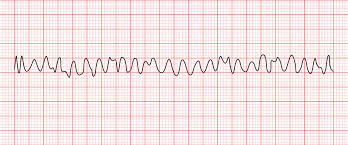Per Inspira policy, when should central line dressings be changed?
What is every 7 days or when loose or soiled?
Hemodynamic monitoring, neurological disorders, retention, obstruction, and palliative care.
What is HORN criteria?
The pressure injury that is full-thickness with loss of skin and exposed adipose visible within the ulcer and granulation tissue.
What is a stage 3 PI?
Documentation must be completed on patients in non-violent and violent restraints every _____ hours.
What is non-violent/every 2 hours?
What is violent/every 2 hours by RN and Q15mins by 1:1 on the observation log?
The tool that is used at Inspira to assess patients fall risk and should be completed by every shift?
What is the Morse Fall Scale?
 You see this on the screen at the tele desk. Your first action would be to....
You see this on the screen at the tele desk. Your first action would be to....
What is check the patient immediately?
You are unable to flush your patient's midline. Now what?
What is changing the luer cap and attempting to flush again?
Still not flushing? What is calling the physician for further orders?
Outlining nursing and physician responsibilities in determining criteria for insertion, continuation, removal and care of a patient with a urinary catheter.
What is Inspira policy for CAUTI prevention?
According to Inspira policy, when should photos of pressure injuries be taken?
What is at admission, discovery of new wound, wounded Wednesdays, transfers to a different unit, upon discharge?
A restraint order needs to be renewed every _____ for non-violent restraints and every _____ for violent restraints.
What is 24 hours for non-violent and 4 hour for violent?
These four activities should be the focus of hourly rounding by nursing staff.
What are the 4 P's (pain, potty, position, possessions)?
A life-threatening organ dysfunction due to a dysregulated host response to infection.
What is sepsis?
Your patient has been admitted to your floor with a PICC line in place. What needs to be done to ensure proper placement of this line?
What is a chest xray?
These five nurse-sensitive interventions are used to reduce and prevent CAUTI.
What is discouraging foley use; performing perineal care prior to insertion; avoiding irrigation unless obstruction is suspected; promoting use of purewicks and primo fit; emptying bag regulary; avoiding contact between spout and container?
When turning patients for routine repositioning, at what angle should the patient be supported to maintain a side lying position?
What is a 30 degree angle?
The medical conditions that need to be ruled out or treated to minimize the need for restraints?
What is fever, hypoxia, hypoglycemia, electrolyte imbalance, medication side effects?
What is the name of the quality improvement program of the ANA (American Nurse Association) that measures nurse sensitive indicators?
What is NDNQI? (National Database of Nursing Quality Indicators)
Two or more of these symptoms: temp >38.3C (100.9) or <36C (96.8); heart rate >90; resp rate >20; WBC > 12,000 or < 4,000; > 10% bands.
What is SIRS criteria?
IV tubing needs to be changed on a regular basis. What is Inspira policy for TPN/PPN and blood tubing?
IV pump tubing?
What is every 24hrs for TPN/PPN, and 2 units of blood or 4hours for blood tubing?
What is 96hrs?
Agitated patients, frequent bowel incontinence, skin irritation/breakdown, urine retention, vaginal bleeding, mobility out of bed without assistance.
What are contraindications for purewick use?
The SSKIN bundle includes these 5 prevention methods.
What is S-skin inspection/assessment; S-support surface; K-keep turning/moving; I-incontinence/moisture management; N-nutrition/hydration?
A licensed provider has to complete a face-to-face evaluation of any patient who has an order to be restrained, within what time frame?
What is immediately or within an hour?
Most falls in the hospital are contributed to what?
What is toileting?
The most common adverse event reported in hospitals each year: roughly 700,000 to 1 million occurrences resulting in ~250,000 injuries and up to 11,000 deaths.
What is falls?
This infection-preventative product is used at the base of all central lines to reduce the risk of CLABSI.
What is a bio-patch/chlorhexidine-impregnated sponge?
The costs that are associated with CAUTI are not reimbursable. What determines this?
What are Medicare regulations?
Maintaining good skin integrity over bony prominences should include the use of this product to protect against pressure injury, friction/shearing, and moisture.
What is optifoam?
When a patient is placed in restraints, it is Inspira policy to add "restraint" to the patients plan of care.
True or false?
What is true?
Name the six risk factors that are highly predictive of falls and entrapment in the hospital?
What is history of falls, secondary diagnosis, ambulatory aids, IV, gait, and mental status?
This product is indicated to prevent bleeding in patients with thrombocytopenia. It is given rapidly, especially when treating coagulopathy in major bleeding.
This product is given for patients with anemia or major blood loss.
This product is indicated for patients with low blood clotting factors or low levels of other blood proteins.
What is Platelets?
What is whole blood or PRBC (packed red blood cells)
What is FFP. (fresh frozen plasma)